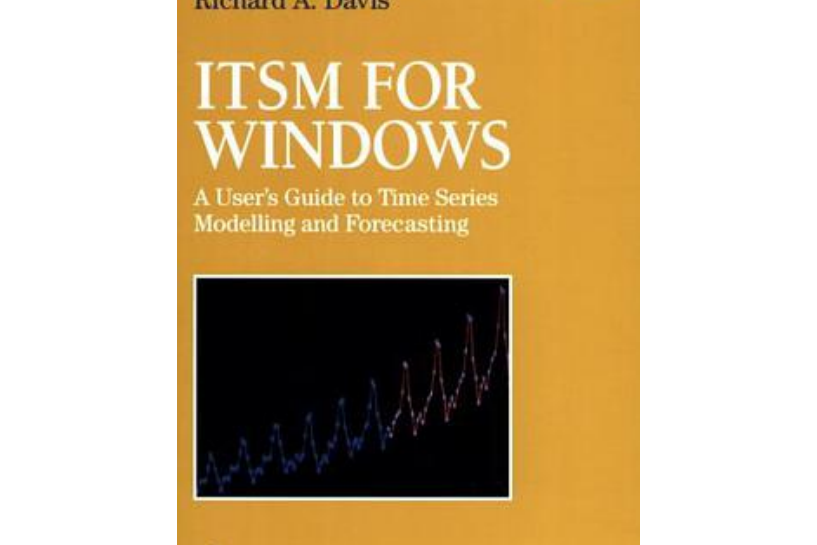《ITSM for Windows》是1994年Springer出版的圖書,作者是Richard A. Davis,Peter J. Brockwell。
基本介紹
- 中文名:ITSM for Windows
- 裝幀:Paperback
- 定價:USD 99.00
- 作者:Richard A. Davis,Peter J. Brockwell
- 出版社:Springer
- 出版日期:1994年08月12日
- ISBN:9780387943374
- 副標題:AUser's Guide to Time Series Modelling and Forecasting
媒體推薦,作者簡介,目錄,
媒體推薦
" Although it has such an easy-to use appearance and a menu driven structure, the programs are surprisingly flexible and many sophisticated time series analyses can be carried out with the package." (Journal of the American Statistical Association)
作者簡介
Dr. Richard A. Davis Jr. was a professor of geology at the University of South Florida until 2005. He is now an emeritus distinguished university professor at USF and visiting professor/research associate at Harte Research Institute, Texas A&M University in Corpus Christi, Texas. His area of specialization is coastal geology with emphasis on beaches, barrier islands, and tidal inlets. He has written/edited 20 books and about 150 journal articles on topics of oceanography, coastal geology, stratigraphy, and sedimentology. He has been a visiting professor in Australia, New Zealand, the Netherlands, Denmark, Spain, and Germany. And he speaks and teaches workshops at universities all over the world. He holds the Shepard Medal in Marine Geology.
目錄
1 Introduction.- 1.1 The Programs.- 1.2 System Requirements.- 1.2.1 Installation.- 1.2.2 Running ITSM.- 1.2.3 Printing Graphs.- 1.3 Creating Data Files.- 2 PEST.- 2.1 Getting Started.- 2.1.1 Running PEST.- 2.1.2 PEST Tutorial.- 2.2 Preparing Your Data for Modelling.- 2.2.1 Entering Data.- 2.2.2 Filing Data.- 2.2.3 Plotting Data.- 2.2.4 Transforming Data.- 2.3 Finding a Model for Your Data.- 2.3.1 The ACF and PACF.- 2.3.2 Entering a Model.- 2.3.3 Preliminary Parameter Estimation.- 2.3.4 The AICC Statistic.- 2.3.5 Changing Your Model.- 2.3.6 Parameter Estimation; the Gaussian Likelihood.- 2.3.7 Optimization Results.- 2.4 Testing Your Model.- 2.4.1 Plotting the Residuals.- 2.4.2 ACF/PACF of the Residuals.- 2.4.3 Testing for Randomness of the Residuals.- 2.5 Prediction.- 2.5.1 Forecast Criteria.- 2.5.2 Forecast Results.- 2.5.3 Inverting Transformations.- 2.6 Model Properties.- 2.6.1 ARMA Models.- 2.6.2 Model ACF, PACF.- 2.6.3 Model Representations.- 2.6.4 Generating Realizations of a Random Series.- 2.6.5 Model Spectral Density.- 2.7 Nonparametric Spectral Estimation.- 2.7.1 Plotting the Periodogram.- 2.7.2 Plotting the Cumulative Periodogram.- 2.7.3 Fisher’s Test.- 2.7.4 Smoothing to Estimate the Spectral Density.- 3 SMOOTH.- 3.1 Introduction.- 3.2 Moving Average Smoothing.- 3.3 Exponential Smoothing.- 3.4 Removing High Frequency Components.- 4 SPEC.- 4.1 Introduction.- 4.2 Bivariate Spectral Analysis.- 4.2.1 Estimating the Spectral Density of Each Series.- 4.2.2 Estimating the Absolute Coherency Spectrum.- 4.2.3 Estimating the Phase Spectrum.- 5 TRANS.- 5.1 Introduction.- 5.2 Computing Cross Correlations.- 5.3 An Overview of Transfer Function Modelling.- 5.4 Fitting a Preliminary Transfer Function Model.- 5.5 Calculating Residuals from a Transfer Function Model.- 5.6 LS Estimation and Prediction with Transfer Function Models.- 6 ARVEC.- 6.1 Introduction.- 6.1.1 Multivariate Autoregression.- 6.2 Model Selection with the AICC Criterion.- 6.3 Forecasting with the Fitted Model.- 7 BURG.- 7.1 Introduction.- 8 ARAR.- 8.1 Introduction.- 8.1.1 Memory Shortening.- 8.1.2 Fitting a Subset Autoregression.- 8.2 Running the Program.- 9 LONGMEM.- 9.1 Introduction.- 9.2 Parameter Estimation.- 9.3 Prediction.- 9.4 Simulation.- 9.5 Plotting the Model and Sample ACVF.- Appendix A: The Screen Editor WORD6.- A.1 Basic Editing.- A.2 Alternate Keys.- A.3 Printing a File.- A.4 Merging Two or More Files.- A.5 Margins and Left and Centre Justification.- A.6 Tab Settings.- A.7 Block Commands.- A.8 Searching.- A.9 Special Characters.- A.10 Function Keys.- A. 11 Editing Information.- Appendix B: Data Sets.

